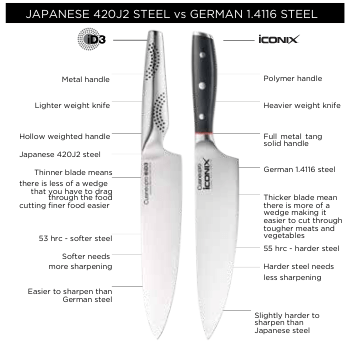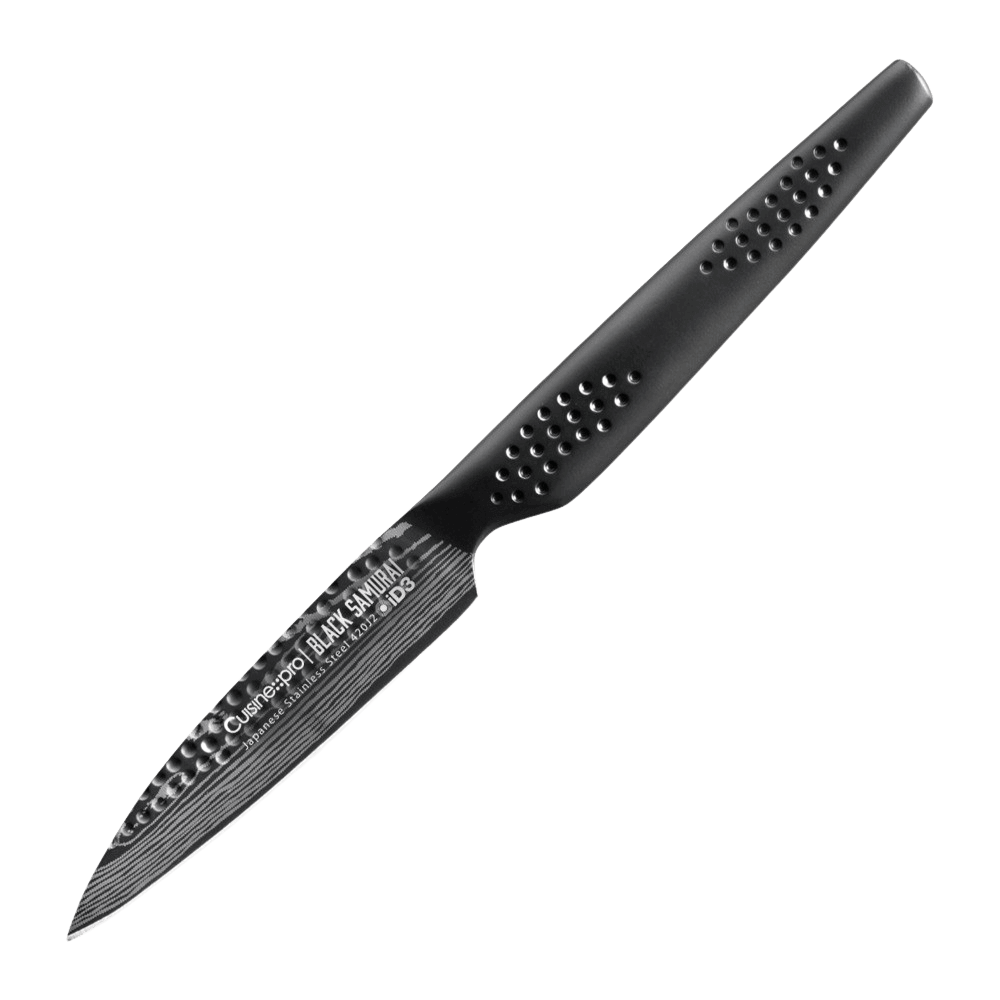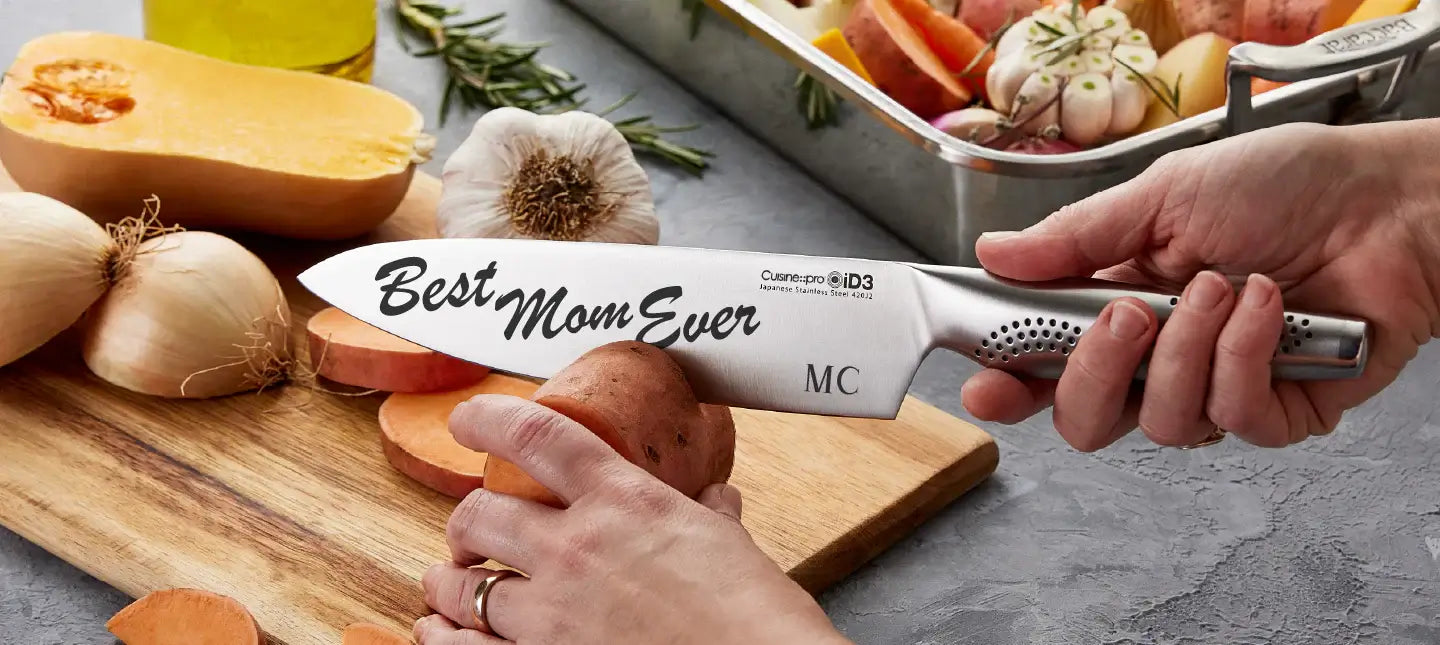Article: What Knife Do I Need?

What Knife Do I Need?
What knife do I need? Your complete guide to the different types of kitchen knives and the best kitchen knives suite for you.
We believe that everyone should have quality kitchen knives. A sharp, strong, reliable, and long-lasting knife is a kitchen essential. Choosing the best knives for cooking can be challenging? At THE CUSTOM CHEF™ we want you to get the most out of your knives. After all these are an investment and we don’t want a good kitchen knives going to waste or to collect dust.
To help you maximum use, we break down everything you need to know about the types of essential kitchen knives available, how to use good kitchen knives and what they are best knifes suited for. We will also explore types of steel including forged vs stamped steel and the difference in materials between Japanese Steel, German Steel, and Stainless Steel. Let’s get started!
What are the Different Types of Knives?
What is it: The best chef’s knife is often hailed as the workhorse of the kitchen for good reason. Typically ranging from 6 to 8 inches in size, it's commonly found with an 8-inch blade. With its generous proportions, featuring a hefty heel and a gracefully tapering blade that culminates in a fine, pointed tip, this knife is designed to facilitate a smooth rocking motion on the cutting board, ensuring each slice is nothing short of perfection. It's the culinary companion you can rely on to effortlessly tackle any task with finesse and precision. That’s why they are the best knives for cooking.
When to use it: The best chef’s knife can be used 99% of the time making it one of the most versatile and perfect all-rounder knives for slicing, dicing, and mincing. The best kitchen knife will do the hard work for you and will little effort, making you a pro in the kitchen. Ideal for preparing thicker portions and harder foods such as potatoes, meat, chopping nuts, etc. A mini chef’s knife is at its best when making classic cuts such as julienne, dice and fine chop fruits and vegetables.

What is it: Think of the utility knife as the chef’s knife’s sibling. Just as universal as the chef’s knife and is used when no other knife will do, or the chef’s knife is just a little too big for the job. Typically ranging between 4 – 6 inches the utility knife has the same shape as a chef’s knife however it is smaller and slimmer with a slightly higher tip.
When to use it: A utility knife is perfect for smaller foods or prepping fruits and veggies. It’s incredibly handy for cuts that require a bit of depth like slicing meats and cheeses, chopping smaller fruits and vegetables such as peaches or broccoli, or slicing breads and sandwiches.

What is it: Also known as a vegetable knife or peeling knife paring knives are small in size but are extremely useful. Offering precision and useful for more intricate tasks the paring knife is typically 2.5 – 4 inches long.
When to use it: Paring knives serve a variety of purposes including peeling, trimming, and coring fruits and vegetables. They excel at precision tasks like cutting small garnishes, deveining prawns, or delicately 'skinning' mushrooms.

What is it: Hailing from Japan, the santoku knife has captured the hearts of home chefs everywhere, earning a well-deserved place in countless kitchens around the globe. Its rise in popularity owes much to its impeccable precision and adaptability. With thoughtful recesses above the blade edge, this knife gracefully liberates thin slices and sticky ingredients after each chop, all thanks to its generously broad blade. And let's not forget its knack for effortlessly scooping and transporting freshly chopped delights—making it not just a tool, but a trusted kitchen companion.
When to use it: Often used the same way to a chef’s knife, a santoku knife is best at chopping up hard vegetables and meats, all with the added refinement of a slightly tapered blade for more intricate cutting work.

What is it: The bread knife as your trusty sidekick for sandwich making, equipped with a serrated edge tailored specifically for the art of bread slicing. Its elongated 8 to 8.5-inch blade delicately navigates through soft loaves and tender cakes, ensuring a pristine cut without any crushing mishaps…. We’ve all had these moments making grilled cheese. Though often overlooked in the kitchen lineup, this unsung hero proves itself time and again with its unmatched convenience, efficiency, and surprising adaptability. Give it a whirl, and you'll find yourself reaching for it more often than you ever thought possible.
When to use it: Unlike other knives, the serrations help when cutting things that are hard on the outside and soft on the inside like bread, cakes, and tomatoes.

What is it: The best kept secret for you kitchen toolkit is kitchen shears. They're like that unexpected friend who becomes indispensable once you get to know them. Easy-motion spring-loaded action and a trusty safety lock make handling them a breeze. And the blade angle? It's spot-on for precise trimming and snipping, effortlessly powering through meat and even the toughest bits of gristle. Once you've experienced the magic of kitchen shears, you'll wonder how you ever managed without them.
When to use it: Kitchen shears make light work of poultry and meats, with the curved blade allowing for effortlessly power cutting around bones and those tricky hard to reach places that knives can’t get to.

What is it: Let's talk about carving knives also known as the boning knife are the sleek, sophisticated cousin of the chef’s knife. They're a bit narrower and can range from 8 to a whopping 15 inches in size. What sets them apart is their elegantly curved blade profile, which works wonders for effortlessly tracing contours and delicately guiding the knife along the meat, smoothly separating it from the bone. With a carving knife in hand, you're not just slicing—you're crafting precise, picture-perfect cuts with every pass.
When to use it: The name speaks for itself—a carving knife is essential for carving thick slices of meats, fruits and vegetables.

What is it: The filleting knives are like the yoga masters of the kitchen, all about flexibility and grace. They’re uniquely crafted to be super thin and flexible, effortlessly bending around every curve and surface. Typically around 8” long, they're your go-to for delicately gliding through food, especially when you're navigating the backbone of a fish. Instead of going straight down, these knives work their magic by gracefully moving horizontally, ensuring you get the perfect cut every time.
When to use it: With a long flexible blade, a filleting knife produces a neater, cleaner, and precise cut making it ideal for removing skin and bones and slicing fillets of fish and steaks.

What is it: Also known as a butcher knife, the cleaver is the best chef knife for handling meat. Also dubbed as butcher knives, the cleaver is a game-changers in your kitchen arsenal. Sporting a manageable length of 6-7inches, these bad boys are designed to pack a punch, with a wide body and just the right weight distribution to effortlessly tackle bones and joints. Say goodbye to struggling with tough cuts. The best kitchen knives are the one’s you wield and you'll wonder how you ever managed without it. The cleaver is that good knife to get into your arsenal.
When to use it: Cleavers are perfectly engineered for portioning larger and smaller cuts of meat and poultry, such as roasts and bigger heavier vegetable varieties.
Types of Knife Manufacturing
Forged steel knives
Forged steel is the solid foundation of craftsmanship. It's created by pounding a single block of steel into shape using a press, then finely honing it for maximum durability, balance, and strength. Sure, some may argue that forged steel comes with a higher price tag, but trust us, it's worth every penny. The extra labor put into crafting a forged knife ensures it'll stand the test of time, becoming a lifelong investment in your culinary journey.
Walk into any professional kitchen, and you'll spot forged knives around the prep areas. Now, they're not just for the pros - these high-quality kitchen essentials have become accessible to home cooks and home chefs as well, elevating the standard of kitchen prep to rival that of renowned chefs worldwide.
Stamped steel knives
Stamped steel is like the cookie-cutter approach to knife making. It starts with a single sheet of metal, cut out into shape and then treated for hardening, sharpening, and polishing. It's a faster process, which is why stamped steel knives often feel lighter and come with a more budget-friendly price tag. But here's the catch, because it's made from a single sheet, these knives might require more frequent sharpening and break easily.
Now, both methods have their ups and downs, but at the end of the day, it's all about the quality of the knife that counts and what your preference is.
Types of Knife Blade Materials
Choosing a blade really comes down to your preference. Always test the knife….how’s the weight? how does it sit in your hand? It should feel like an extension vs a tool.

Japanese steel knives
Japanese steel knives are the sleek athletes of the knife world. Known for their lightweight build and unique hollow metal handles, they boast a seamless design that's not only durable but also incredibly hygienic. Crafted from a single piece of metal formed into a thin blade, they glide through ingredients with unparalleled smoothness. Plus, their balanced weight distribution, carefully positioned in the middle of the knife, ensures precision and control with every slice. While Japanese steel may be slightly softer, it's a breeze to sharpen, making maintenance a cinch.
German steel knives
German steel knives are built with the perception of being tough. These are seen in most older kitchens. They’re a heavy-weighted knife, typically with a triple riveted wooden or polymer handle for support. The metal blade also extends through to the handle allowing for increased force and leverage when cutting. The steel is harder which requires less sharpening, however, as a result can be slightly harder to sharpen.
Stainless steel knives
Stainless steel is reputable for its durability, strength and is most commercially accessible. Knives made of stainless steel are resistant to staining and rust, however, the same care needs to be considered for long lasting results.
Which Knife is Right for Me?
The wonderful world of knives, where there's a blade for every task, and some are more specialized than others. Whether you're just starting out in the kitchen or dreaming of becoming a Michelin star chef, you've got to admit, every knife has its moment to shine.
Now, when it comes to building your kitchen essential toolkit, it's all about starting with the essentials. Kick things off with a trusty all-rounder like a Santoku or a chef's knife, then spice things up with a couple of utility knives in different sizes, and hey, don't forget the boning for those crusty loaves!
Once you've got your collection sorted, the real challenge begins. Finding a safe home for those sharp beauties. Enter the hero of the hour, the knife block. It's like the cozy little neighborhood where your knives can kick back and relax after a hard day's work. Plus, it's becoming the hip new trend in kitchen storage. Who knew organizing your blades could be so stylish?
What was once considered an unsightly wooden chunk on the benchtop, knife blocks have really evolved into art pieces in their own right. Displaying knife blocks is considered a home kitchen styling statement.
For anyone in the market for their first set, THE CUSTOM CHEF™ recommend starting with a 6 or 7-piece knife block, which features all your essential knives in one set:
1 kitchen shear (optional)
Most of our knife blocks come with the most coveted 1 bread knife.
For more experienced cooking enthusiasts with a knife block already, choosing standalone knives to complement your collection is never a bad thing.
By reading this guide we hope you learned enough to help you decide about what you require to create a complete and efficient culinary experience. Check out our selection of kitchen knives to find your perfect match.


